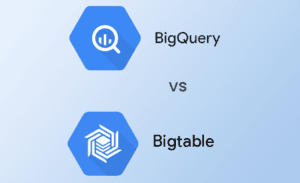Jan 28, 2024


Bigtable vs. BigQuery is a thought-provoking question. Google Cloud Platform hosts Bigtable and BigQuery. Bigtable is a high-performance storage system. Whereas, BigQuery is an enterprise data warehouse. Bigtable can scale to store and collect petabytes of data. And BigQuery manipulates your big data storage for answers.
Bigtable and BigQuery are cloud-native. They have unique features and use cases in the big data ecosystem.
This article explains Bigtable and BigQuery: their characteristics, similarities, and differences.
What is Bigtable?
Bigtable is a NoSQL database known as the ‘Database as a Service’ (DaaS) solution. It is a fully managed wide-column and key-value storing database.
Bigtable handles a large amount of data over distributed systems. It has a storage data model. Applications that require high throughput and key value scalability use Bigtable. Bigtable is ideal for processing day-to-day business activities.
Features
Below is a list of critical features of Bigtable.
It can scale to store billions of rows with low latency.
Bigtable is capable of handling heavy read and write operations.
As a distributed storage system, you can use it to manage large-scale structured data.
It easily integrates with other data tools such as Hadoop, Dataflow, and Dataproc.
Products like Google Analytics, Finance, and Earth run on Bigtable.
What is BigQuery?
BigQuery is a fully-managed serverless SQL data warehouse. It is also a ‘Platform as a Service’ (PaaS) tool. Quick responses to user queries are possible with Bigtable. Analytical and operational applications are popular use cases of BigQuery. The most common applications of BigQuery are Business Intelligence and Data Analytics.
Features
Here is a list of key features of BigQuery:
BigQuery is a robust Business Intelligence platform.
It has built-in machine-learning capabilities.
It offers scalable analysis over large datasets such as petabytes of data.
It has super-fast data processing speed - scanning billions of rows in seconds.
It creates real-time analytics reports. With BigQuery, businesses make informed decisions using data insights.
Bigtable vs. Bigquery: What Do They Have in Common?
Both services are excellent customer-serving solutions. You don’t have to worry about downtime while planning for maintenance. System updates do not affect your workflow. Both of these database tools have unlimited scalability, automatic sharding, and restore backups. They separate processing and storage functions which increase throughput.
Bigtable vs. BigQuery: 4 Key Differences
Salient differences are discussed below:
Processing (OLTP vs. OLAP)
Bigtable is an OLTP (Online Transactional Processing) solution. OLTP deals with transactional data. It offers high processing speed to handle read and update operations. You can run OLAP operations in it as well.
BigQuery is best suited for OLAP (Online Analytical Processing) workloads. OLAP supports read operations only. It is mainly used in reporting and archiving activities.
Database (NoSQL vs. SQL)
Bigtable is a NoSQL database in that SQL transactions are impossible. Therefore, Bigtable is ideal for changeable data sets. BigQuery is an SQL database and a hybrid model. It allows complicated analytical queries.
Storage (Mutable vs. Immutable)
Bigtable is a sparse and multidimensional map. Its data model uses rows, columns, and timestamp values for indexing. It organizes data into a table that can scale. Thus, the storage is mutable with quick lookups.
BigQuery comes with immutable data. You cannot change or delete the data object for its storage lifespan. This database has an “append-only” nature. As a result, BigQuery automatically removes existing records older than a pre-configured time.
Solution (Time-Series Data vs. Search Queries)
Bigtable is ideal for Time-Series data such as memory utilization and CPU. You can use it to handle financial data such as exchange rates and transition history. Bigtable works with all types of data over massive clusters. And Bigtable powers many applications at Google, such as Google Earth and web index.
BigQuery works best with search queries throughout the database. It does not replace typical Relational Databases. Therefore, it has limitations on data size per request and daily table updates.
Bigtable vs. BigQuery: Which Tool to Choose for What Application?
Companies use Bigtable to manage and structure their large data sets. They use BigQuery to gain insights from a large amount of data. Below are some application scenarios for both databases.
Bigtable Use Cases
Time series data
Internet of things data
Financial data
Marketing data
Digital fraud detection
Personalized product recommendations systems
BigQuery Use Cases
Log analysis
Real-time analytics
Real-time fraud detection
Create a Collaborative & Synchronized Data Workflow
This article gives an overview of the two database services, features, and use cases. The two databases have several similarities but are notably different.
Bigtable and BigQuery differ in terms of processing, storage, and database. Bigtable is a NoSQL database, a mutable OLTP solution. It works best with time-series data. BigQuery is an SQL database, an immutable OLAP system. It performs high-volume search queries.
You can complement your workspace by integrating Sherloq with BigQuery. Sherloq is an add-on that makes your data collaborative and synchronized across teams.
The value prop is that our platform is an add on on their exist workspace
and that we reduce their time spending on finding and searching their data and giving them the opportunity to make the data self-served
With the Sherloq add-on you can easily do the following things directly from BigQuery:
Save repetitive queries (SQL code) with the "Add a Query" option.
Sherloq automatically records your query history and lets you view all your past written codes.
Search specific code from your saved query history.
Sherloq team is also working on introducing the following exciting features:
Easily share code with your partners.
Create shared folders and collaborative business definitions.
Receive notifications on similar queries and best practices.
Sherloq helps optimize workflow by reducing data search time and offering query auto-corrections. It also has an enterprise solution for data leaders to create unified data culture at scale. Get Sherloq for free to make your data self-served.
Get Sherloq Free

